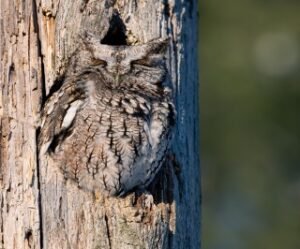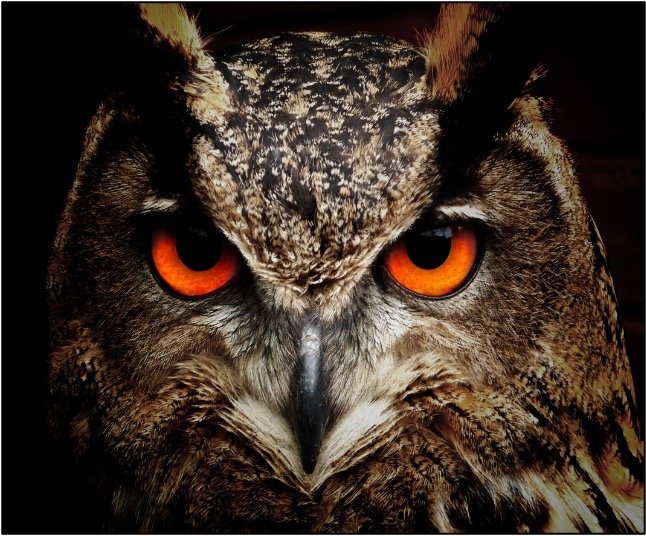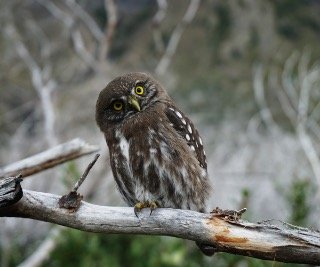
Owls in Virginia
Owls are fascinating birds found all over the world, including Virginia in the United States. Virginia is home to a wide variety of owl species, each with its own set of characteristics and habitats.
The great horned owl, barred owl, Eastern screech owl, and barn owl are among the most common owl species in Virginia. With a wingspan of up to 5 feet, the great horned owl is the largest owl species found in Virginia.
The barred owl is a medium-sized owl with distinctive brown and white striped feathers. The Eastern screech owl is a smaller owl species that can be found in a variety of habitats ranging from urban areas to forests.
Despite their nocturnal habits, owls are an important part of Virginia’s ecosystem, playing an important role in rodent population control. They are also popular with bird watchers and photographers who enjoy observing and photographing their unique behaviors and stunning appearance.
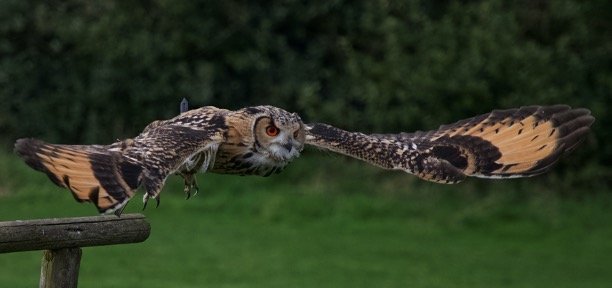
Where To Find Owls in Virginia
Owls can be found in a variety of habitats throughout Virginia, including forests, wetlands, farmlands, and suburban areas. Here are some specific locations in Virginia where owls may be found:
1. Shenandoah National Park: This Blue Ridge Mountains park is home to several owl species, including the barred owl, Eastern screech owl, and great horned owl. The park also provides guided nature walks and owl prowls led by rangers.
2. Great Dismal Swamp National Wildlife Refuge: The Great Dismal Swamp National Wildlife Refuge in southeastern Virginia is home to several owl species, including the barred owl, Eastern screech owl, and barn owl. The refuge provides guided nature walks as well as birdwatching tours.
3. Virginia Beach: Virginia Beach’s coastal areas are home to several owl species, including the Eastern screech owl and the great horned owl. They can be found in wooded areas near residential areas or along the beach.
4. Sky Meadows State Park: Located in northern Virginia, this park is home to several owl species, including the barred owl and the Eastern screech owl. The park provides guided nature walks and owl prowls led by rangers.
5. Mason Neck State Park: Mason Neck State Park in northern Virginia is home to a variety of owl species, including the barred owl and the Eastern screech owl. The park provides guided nature walks and owl prowls led by rangers.

How to Find an Owl in Virginia?
Finding an owl in Virginia can be a rewarding but difficult experience. Here are some tips for increasing your chances of seeing an owl:
1. Understand their habitat: Different owl species require different environments. Others prefer open fields or wetlands, while some prefer wooded areas. Investigate the owl species you want to observe to learn about their preferred habitat.
2. Listen for their calls: Owls have distinct calls that can assist you in locating them. You can learn about different owl species’ calls and listen for them during their active hours.
3. Look for roosting sites: During the day, owls frequently roost in trees, snags, or other structures. Look for areas with large trees, snags, or nesting boxes that could provide suitable roosting habitat.
4. Check for pellets: Owls regurgitate pellets, which are compact masses of indigestible material such as fur, bones, and feathers. Look for pellets at the base of trees or other roosting sites, which can indicate the presence of owls.
5. Go on a guided tour: Join a guided tour with a knowledgeable naturalist or birdwatcher to learn about owl behavior and increase your chances of spotting one.
Can You Own an Owl in Virginia?
No, it is illegal in Virginia to own an owl or any other wild bird species without the proper permits and licenses. The Virginia Department of Game and Inland Fisheries regulates the possession, transportation, sale, or purchase of native wildlife, including owls, under state and federal law, including the Migratory Bird Treaty Act.
Thirteen Owls Species in Virginia:
- Barn Owl
- Eastern-screech Owl
- Great Horned Owl
- Snowy Owl
- Barred Owl
- Long-eared Owl
- Short-eared Owl
- Northern Saw-whet Owl
- Flammulated Owl
- Burrowing Owl
- Western-screech Owl
- Northern Pygmy Owl
- Mexican Spotted Owl
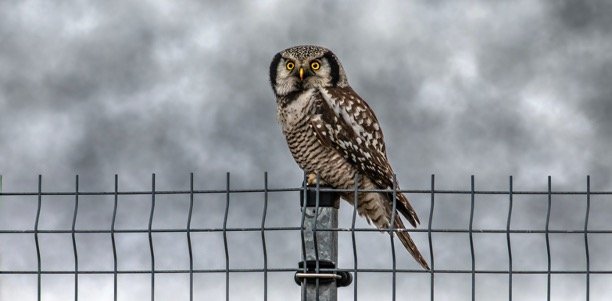
The Great Horned Owl is the largest owl in Virginia, and the Northern Saw-whet Owl is the smallest. Owls are predatory birds that hunt and consume small mammals, as well as snakes, frogs, and insects.
Owls consume their prey whole, frequently after removing the head, and regurgitate the bones and fur. For the best chance of seeing owls in Virginia, go to a wooded area at dawn or dusk. Consider high vantage points on the forest’s edge that overlook open grassland or pastures.
13 Species of Owl in Virginia
1. Barn Owl
The Barn Owl can be seen in Virginia all year, but it is not very common. This silent nocturnal bird with a white face is about the size of a crow.
- Length: 12.6-15.8 in (32-40 cm)
- Weight: 14.1-24.7 oz (400-700 g)
- Wingspan: 39.4-49.2 in (100-125 cm)
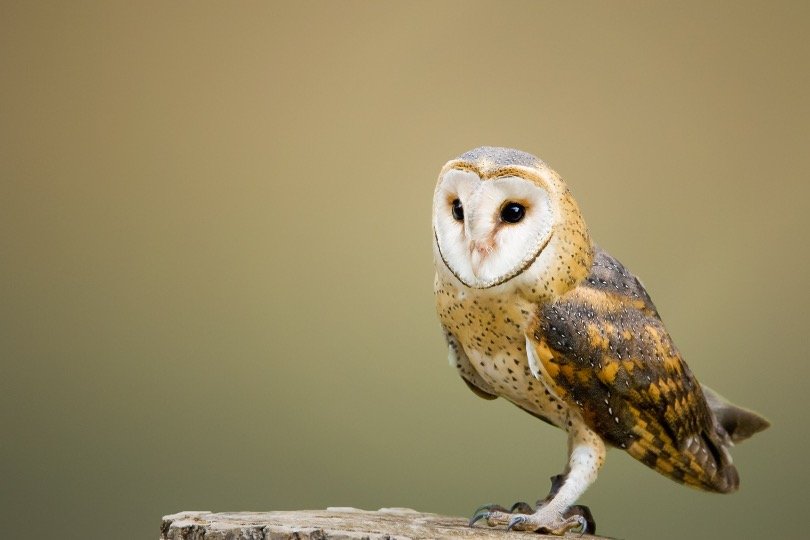
Barn owls have buff-colored backs and white faces, chest, and belly, as well as underwings. Their faces are round, and they have long, rounded wings and short tails. Females have parasite-repelling spots on their chests, and the greater the number of spots on the female’s chest, the greater the amount of contribution the male makes to the construction of the nest!
It is believed that they search for tiny rodents across open ground at night, such as fields and meadows, and that their name comes from the fact that they frequently roost in barns during the day.
15 Cutest Owls In The World
Barn owls eat their food whole and cough up pellets twice a day, according to the National Wildlife Federation. As with all animals examined, the Barn Owl hunts for prey largely by sound because it has the finest hearing of any species.
Listen Barn Owl Hoot:
Credit: Manceau Lionel, XC659876. Accessible at www.xeno-canto.org/659876.
These abilities enable them to hunt down and capture prey in full darkness, including those hiding beneath plants or in a show. They construct their nests in tree cavities, caves, and, more frequently, in barns or other abandoned or silent structures, according to the National Wildlife Federation.
The nest is formed of regurgitated pellets that have been organized into a cup by their feet and placed inside a cup. They lay between 2 and 18 white eggs throughout the course of 1 to 3 broods.
Approximately 46 species of Barn Owls may be found throughout the world, and they can be found on all six continents. Instead of hooting like other owls, they make a scratchy scream call that is difficult to understand.
2. Eastern Screech Owl
The Eastern Screech-Owl can be seen in Virginia all year and is common east of the Rockies.
- Length: 6.3-9.8 in (16-25 cm)
- Weight: 4.3-8.6 oz (121-244 g)
- Wingspan: 18.9-24.0 in (48-61 cm)
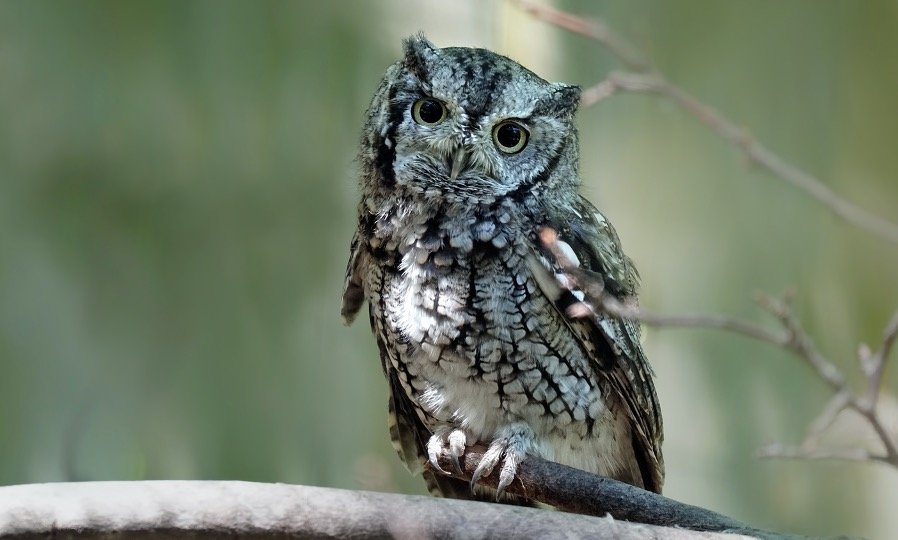
Gray and red are the colors of this short, stocky bird. A robin’s size is comparable to that of a crow, but they are more bulkier, with a large head and little neck. As a result of their camouflage patterns and spots, they are difficult to distinguish against tree bark.
When looking for the Eastern Screech-Owl, look for it in woodlands and parks, where you may be able to notice it sunning itself in a tree cavity on cold sunny days, or by the flurry of songbirds that flock to them when they discover them.
5 Simple & Proven Ways To Attract Owls To Your Yard
Another telltale sign is a collection of pellets on the ground. They can be identified by their harsh, descending whinny sound and vibrating trill. Eastern Screech-Owls prey on a wide variety of tiny animals, including birds, mammals, insects, reptiles, and amphibians.
Listen Eastern Screech Owl Hoot:
Credit: Lance A. M. Benner, XC513355. Accessible at www.xeno-canto.org/513355.
They hunt primarily at night, although they also hunt at dawn and twilight, and they are nocturnal. They typically sit on perches and wait for prey to pass by before leaping to their death from them.
Given that they are unable to excavate their own nests, the Eastern Screech-Owl typically makes use of abandoned woodpecker nests as well as other holes and cavities. Their eggs are laid on whatever trash available at the bottom of the cavity because they do not employ nesting material. They lay between 2 and 6 white eggs every time they lay an egg.
3. Great Horned Owl
Throughout the year, the Great Horned Owl can be seen in Virginia and throughout North America, including Canada. They are large owls with thick bodies and large tufts of hair on their heads that resemble ears.
- Length: 18.1-24.8 in (46-63 cm)
- Weight: 32.1-88.2 oz (910-2500 g)
- Wingspan: 39.8-57.1 in (101-145 cm)

In appearance, the Great Horned Owl is a grey-brown bird with a mottled pattern and a white patch on its throat. A deep hooting call can be heard from their nest. Their wings are large and rounded.
One of the most common owls in North America, the Great Horned Owl can be found in a range of environments, including woods, deserts, urban areas, and grasslands, among others. These ferocious hunters feed on birds and mammals that are far greater in size than they are.
6 Largest Owls In The World: Everything You Need To Know
Besides ospreys and falcons, they will also go after owls and other raptors such as peregrine falcons. Their wide diet includes small rodents such as mice or skunks, geese and hares, insects, fish, and carrion, to name a few ingredients.
Listen Great Horned Owl Hoot:
Credit: Lance A. M. Benner, XC545009. Accessible at www.xeno-canto.org/545009.
They are not picky eaters and will eat practically everything you put in front of them! When building their nests in trees, Great Horned Owls frequently re-use old nests that were previously used by another species.
Occasionally, they will line the nest with bark, leaves, downy feathers, or pellets, although they will also leave the nest unlined on occasion. They lay anything from one to four white eggs.
4. Snowy Owl
However, they are only found in Virginia during the winter months because it is the southernmost point of their winter range. They are white birds with modest amounts of black or brown patterns, yellow eyes, and are around the size of a crow in terms of size and appearance.
- Length: 20.5-27.9 in (52-71 cm)
- Weight: 56.4-104.1 oz (1600-2950 g)
- Wingspan: 49.6-57.1 in (126-145 cm)
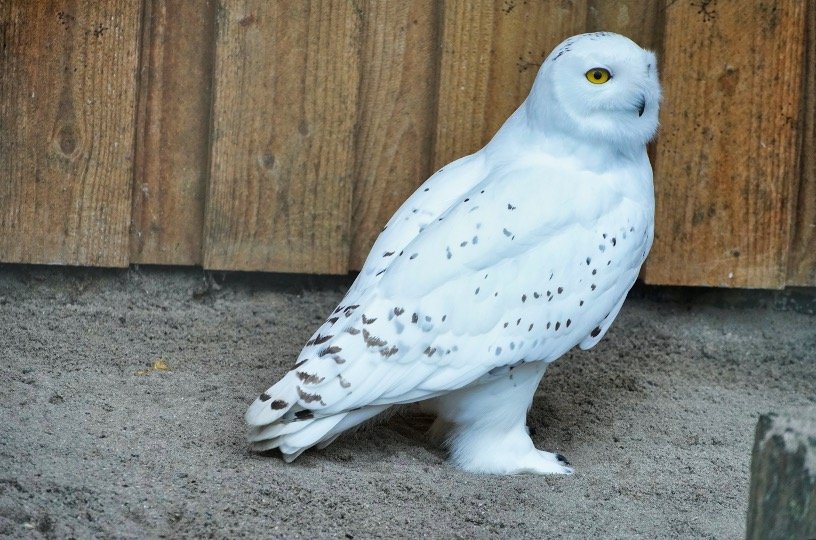
Even against a snowy backdrop, they can be difficult to notice, but they prefer to sit on high ground, which makes them easier to locate. They are normally deafeningly quiet, but during the breeding season they may emit a harsh croak or shrill whistle to attract mates.
Where Do Owls Nest? Everything You Need To Know
Snowy Owls, in contrast to other owls, are diurnal, meaning they hunt in the arctic during the entire 24-hour summer daylight period. They prey on small mammals, primarily lemmings, and can ingest as many as 1600 of them in a single year, according to some estimates.
Listen Snowy Owl Hoot:
Petr Suvorov, XC219348. Accessible at www.xeno-canto.org/219348.
It is also possible to catch flying birds such as ptarmigan and ducks. During the winter, they will prey on rodents, rabbits, squirrels, and birds such as ducks and geese, among other things.
The Snowy Owl’s nest is merely a shallow depression in the tundra that has been scratched out by the animal.
They seek a windswept ridge that will be blown clear of snow, and they keep the nest for many years until discarding it altogether. They lay anything from 3 to 11 white eggs per clutch.
5. The Barred Owl
The Barred Owl can be found in Virginia all year. These large, stocky birds are roughly the size of a crow or a goose.
- Length: 16.9-19.7 in (43-50 cm)
- Weight: 16.6-37.0 oz (470-1050 g)
- Wingspan: 39.0-43.3 in (99-110 cm)

Barred Owls are brown and white in color, with a mottled pattern of vertical stripes on the belly and horizontal stripes on the back and upper chest. They have black eyes, a round head with no ear tufts, and a rounded tail.
Listen Barred Owl Hoot:
Credit: wisconagus, XC691476. Accessible at www.xeno-canto.org/691476.
The Hoohoo call of the Barred Owl is a loud barking hoohoo call. They hunt for small creatures such as squirrels, rabbits, birds, and voles by perching on a high perch and keeping an eye out for their movements.
Baby Owl Sleeping Face Down Is Unbelievable (With Picture)
This species prefers to reside in vast, mature forests, frequently near bodies of water, and lays 1-5 white eggs in tree cavities.
6. Long-eared Owl
The Long-eared Owl can be found throughout the year in Virginia, although after breeding, it may travel further south from the state’s northernmost reaches after breeding. They are medium-sized, slender owls, about the size of a crow, and they have a shocked expression on their faces when they see you.
- Length: 13.8-15.8 in (35-40 cm)
- Weight: 7.8-15.3 oz (220-435 g)
- Wingspan: 35.4-39.4 in (90-100 cm)
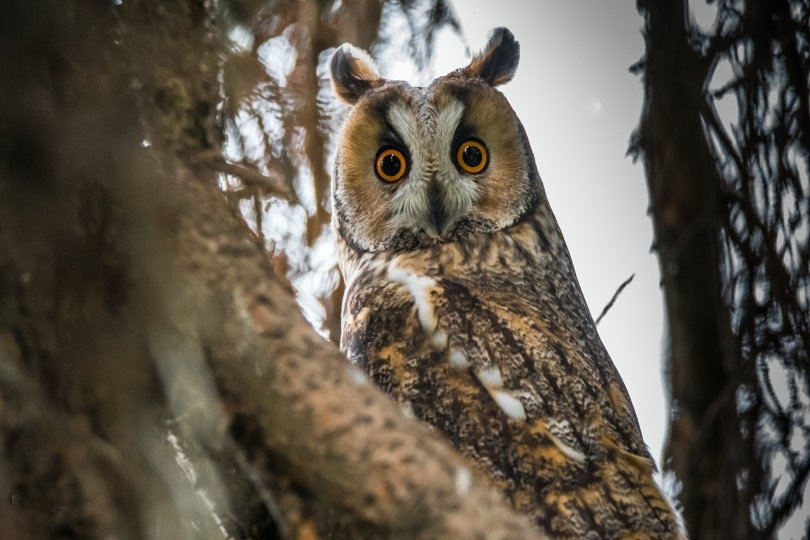
Long-eared Owls have patterned black and brown feathers, buff faces, big black or buff ear tufts, and yellow eyes. Long-eared Owls are found in the northern hemisphere.
Sleeping Owls Are So Adorable: Pictures & Fun Fact
In the evening, they congregate in dense woodlands, where they are effectively concealed, yet close to grassland, where they can forage for food during the day.
Listen Long-eared Owl Hoot:
Credit: András Schmidt, XC699379. Accessible at www.xeno-canto.org/699379.
Among the tiny mammals that Long-eared Owls eat are voles, mice, juvenile rats, and rabbits, among other things. They hunt over broad grassland or pastures by hovering only a few feet above the ground and listening for movement or looking for it with their eyes and ears.
They lay between 2 and 10 white eggs in stick nests that have been abandoned by other animals.
Long-eared Owls are rarely heard, with the exception of during the nesting season. Hoots and whistles at low pitches, as well as shrieks, screams, and meows that sound like cats, are all produced by them.
7. Short-eared Owl
Following breeding, the Short-eared Owl can be located in Virginia throughout the winter months, having migrated from northern states and Canada during the breeding season. They are around the size of a crow and have ear tufts that are relatively little in comparison.
- Length: 13.4-16.9 in (34-43 cm)
- Weight: 7.3-16.8 oz (206-475 g)
- Wingspan: 33.5-40.5 in (85-103 cm)
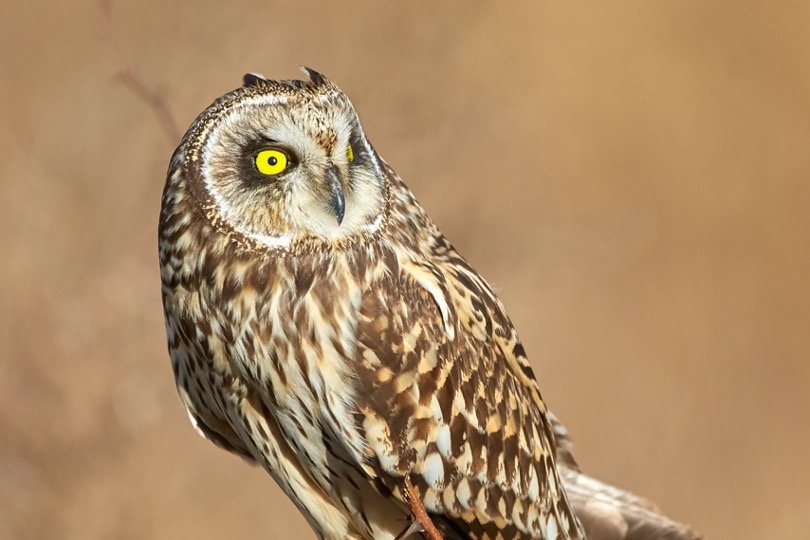
Short-eared Owls have mottled black, brown, and white coloring, a pale face, and yellow eyes with a black rim that are rimmed with black. Their wings are large and rounded, and they have a short tail.
31 Interesting Owls Facts You Don’t Want To Miss
Instead of hunting at night, the Short-eared Owl hunts during the day, primarily at sunrise and sunset. It is their prey, small mammals such as voles and mice, that they are hunting, as they fly low over the ground, seeking for and listening for movement.
Listen Short-eared Owl Hoot:
Credit: Romuald Mikusek, XC669188. Accessible at www.xeno-canto.org/669188.
Short-eared Owls are also one of a kind in that they build their own nests by scraping the ground into a bowl and lining it with grass and soft feathers, which is a first for the species. They lay between one and eleven cream or white eggs per clutch.
They are not extremely noisy, although the males will produce approximately a dozen hoots during courtship, and when protecting the nest, they may bark, whine, or scream. They are nocturnal, but they are active throughout the day.
8. Northern saw-whet Owl
The Northern Saw-whet Owl can be seen in Virginia all year. This tiny owl is roughly the size of a robin.
- Length: 7.1-8.3 in (18-21 cm)
- Weight: 2.3-5.3 oz (65-151 g)
- Wingspan: 16.5-18.9 in (42-48 cm)
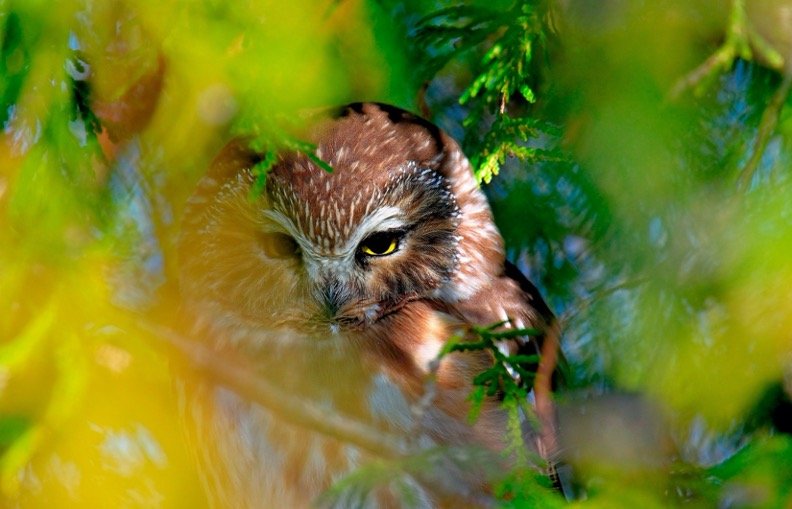
Northern-Saw-whet Owls are distinguished by their small bodies and spherical heads. They have a mottled brown body with white spots, a white face with spots, a spotted head with spots, and yellow eyes.
Listen Northern saw-whet Owl Hoot:
Credit: Lance A. M. Benner, XC446701. Accessible at www.xeno-canto.org/446701.
These nocturnal hunters prey on tiny mammals, notably mice, in dense forest environments. It is common for them to construct their nests in tree cavities left by other species, such as Pileated Woodpeckers.
Their eggs are laid directly on the trash rather than on any other type of nesting material used by them. They lay between 4 and 7 white eggs every time they lay an egg.
Owl Legs: Everything You Need To Know (With Pictures)
9. Flammulated Owl
The flammulated owl (Psiloscops flammeolus) is a small migratory North American owl in the family Strigidae. It is the only species placed in the genus Psiloscops.
- Length: 5.9-6.7 in (15-17 cm)
- Weight: 1.5-2.2 oz (43-63 g)
- Wingspan: 15.9-16.1 in (40.5-41 cm)

The flammulated owl is a very small owl, similar in shape to a screech-owl but smaller, with shorter “ear” tufts. The flammulated owl is similar in appearance to the western screech owl, but is only about one-quarter the mass, lacks large ear tufts (but has small ear tufts that are barely visible), and has dark eyes and a different voice.
The Flammulated Owl can be found in the pine trees in Virginia. It looks like a smaller version of the Screech Owl and has smaller ear tufts. You can find it in various habitats, including desert oases and city parks.
With such large wings for a small body, they can fly rapidly from tree to tree. Males and females can be distinguished by their weight. Females are larger, ranging from 62–65 g (2.2–2.3 oz) and males are smaller ranging from 50–52 g (1.8–1.8 oz).
Listen Flammulated Owl Hoot:
Credit: Frank Lambert, XC408147. Accessible at www.xeno-canto.org/408147.
Flammulated Owls are gray, brown, rust, and white, well camouflaged against bark and leaves. They have a reddish form, a grayish form, and some intermediate plumages, as some screech-owls do.
Flammulated Owls roost by day and hunt flying insects by night in the canopy of mature trees and understory. They locate prey visually and capture them in quick sallies from a perch.
The flammulated owl nests in tree cavities and has two to four young at a time after a 26-day incubation period. The young are able to forage for their own prey after about 25–32 days.
10. Burrowing Owl
The burrowing owl (Athene cunicularia), also called the Shoco, is a small, long-legged owl found throughout open landscapes of North and South America.
Virginia’s open country habitats and beaches attract the Burrowing Owl. This owl was once called the Howdy Bird by cowboys because it nods its head while it’s perching near its burrow.
- Length: 7.5-9.8 in (19-25 cm)
- Weight: 5.3 oz (150 g)
- Wingspan: 21.6 in (55 cm)
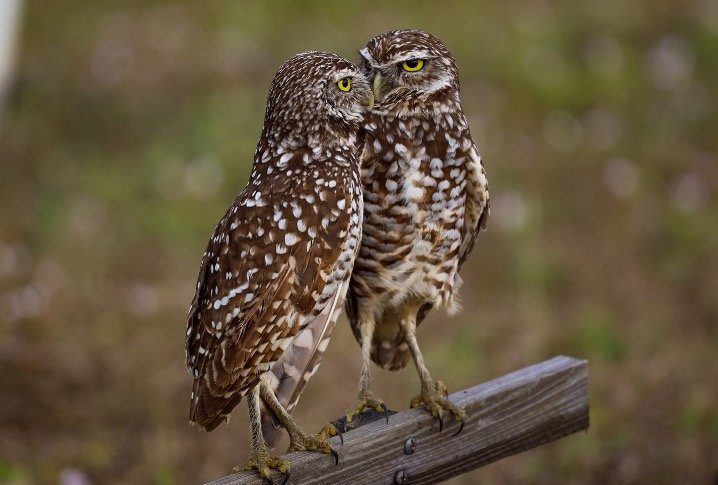
Burrowing owls have bright eyes; their beaks can be dark yellow or gray depending on the subspecies. They lack ear tufts and have a flattened facial disc.
The owls have prominent white eyebrows and a white “chin” patch which they expand and display during certain behaviors, such as a bobbing of the head when agitated. Adults are brown birds mottled with sandy-pale spots on the upperparts.
The breast is spotted, grading to dark brown bars on the belly. They have a bold white throat and eyebrows, and yellow eyes. The brown juveniles are less mottled than adults, with buffy-yellow underparts and wing patch.
Listen Burrowing Owl Hoot:
Credit: David Ricardo Rodríguez-Villamil, XC524491. Accessible at www.xeno-canto.org/524491.
Burrowing Owls spend most of their time on the ground or on low perches such as fence posts. They hunt close to the ground catching insects and small animals. When alarmed they jerk their bodies quickly up and down.
They are active during the day. Unlike other owls that nest on trees and cavities, the Burrowing Owl prefers to nest in burrows excavated by the prairie dog.
It also takes the burrows of ground squirrels and tortoises. It’s pretty rare to see in Virginia, and its perfect camouflage makes it more difficult to find.
11. Western Screech Owl
The western screech owl (Megascops kennicottii) is a small owl native to North and Central America, closely related to the eastern screech owl. Females are larger than males and northern populations are notably larger than southern populations.
- Length: 7.5-9.8 in
- Weight: 3.5-10.8 oz
- Wingspan: 21.6-24.4 in
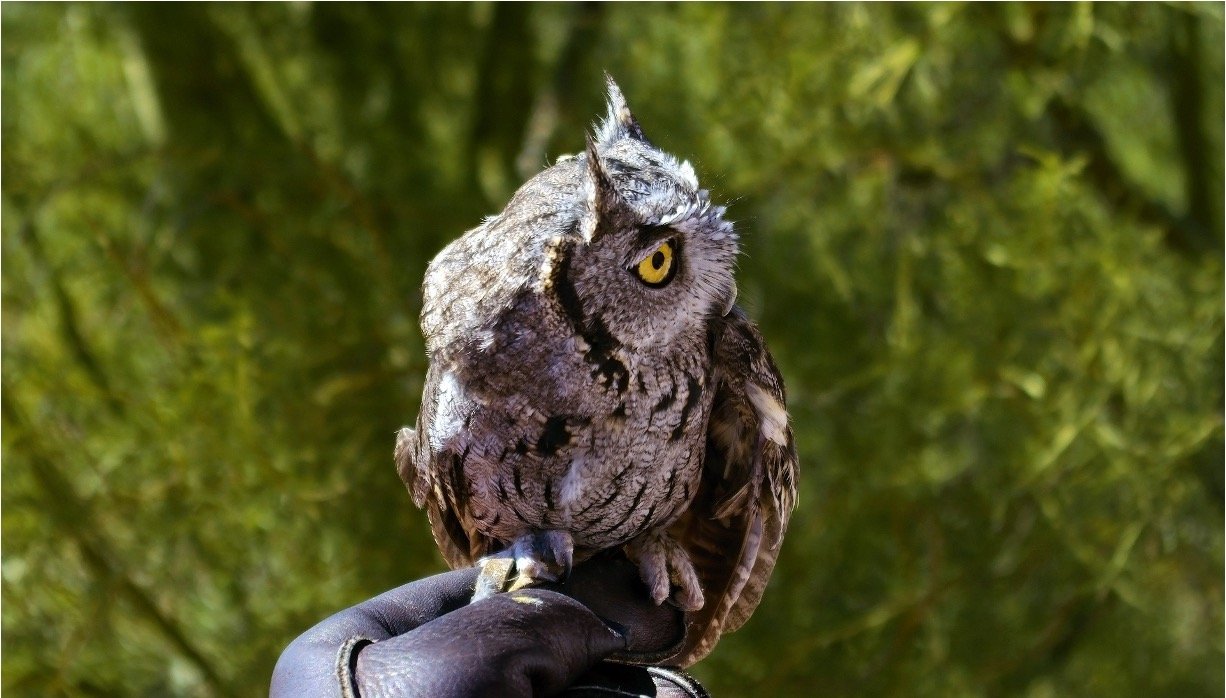
Western Screech Owls can be found in open woodlands as well as urban areas like parks and cities in areas of southern and southeastern Virginia.
Western Screech Owl don’t actually make a screeching sound like their cousin the Eastern Screech-owl but more of a “toot toot” sound.
Listen Western Screech Owl Hoot:
Credit: Lance A. M. Benner, XC540168. Accessible at www.xeno-canto.org/540168.
They nest in tree cavities like the image above but will also take to nest boxes if provided. Screech-owls are small but excellent hunters that can take down prey like rabbits that are larger than their own bodies.
They also have great camouflage and are able to blend in with their surroundings making them difficult to spot.
12. Northern Pygmy Owl
The northern pygmy owl (Glaucidium californicum) is a small owl native to western North America. This owl has a round white-spotted head, weakly defined facial disc, and dark upper breast, wings and tail, the latter quite long compared to other owls.
The eyes are yellow and the bill is yellowish-green. The bird has two black nape spots outlined in white on the back of its head, which look like eyes.
- Length: 6.3-7.1 in
- Weight: 2.1-2.5 oz
- Wingspan: 14.5-16 in
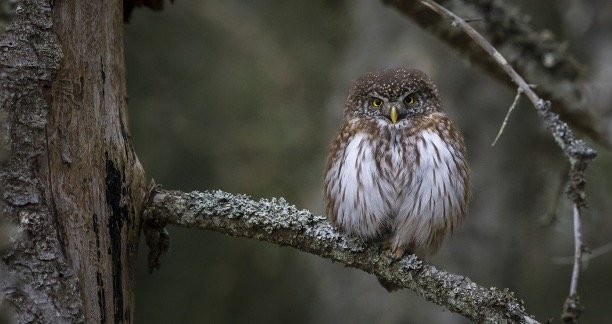
Found mostly in the mountainous regions of western Norther America, the Northern Pygmy Owl is a small owl that feeds mainly on songbirds.
Northern Pygmy Owls are diurnal, or active during the day, giving you a fighting chance to spot one of these tiny guys in Virginia. They sit very still and quiet during the day just waiting to surprise attack their prey for a meal.
Listen Northern Pygmy Owl Hoot:
Credit: Lance A. M. Benner, XC527715. Accessible at www.xeno-canto.org/527715.
Unlike other types of owls, Northern Pygmy Owls will not usually take to man-made nest boxes. In size they are only about as big as an American robin yet are known for taking prey up to 3 times their size.
They can be identified by their small size, yellow beaks and eyes, and white speckles on their heads.
13. Mexican Spotted Owl
The Mexican spotted owl (Strix occidentalis lucida) is one of three subspecies of spotted owl that include the northern spotted owl (S. o. caurina) and the California spotted owl (S. o. occidentalis), and is geographically isolated from each.
The Mexican spotted owl occurs in forested mountains and canyonlands throughout the southwestern U.S. and Mexico. It ranges from Utah, Virginia, Arizona, New Mexico and the western portions of Texas south into several states of Mexico.
- Length: 718.5-18.9 in
- Weight: 17.6-24.7 oz
- Wingspan: 39.8 in
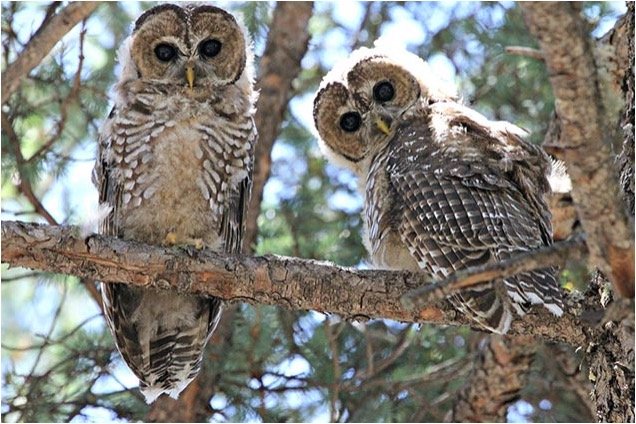
The Spotted Owl, including this subspecies, has a declining population due to habitat loss with an estimated global breeding population of just 15,000 owls.
Over half of these are found in the U.S. with about 40% in Mexico. Another factor that contributes to their declining population is the Barred Owl who is bigger, more aggressive, and is known to drive them away.
The owls prefer the coolest part of the forest, often choosing nest trees on the northern or eastern-facing slopes. Most owlets (baby owls) leave the nest in June, about 35 days after hatching.
Owlets are unable to fly very well when they first leave the nest, and their parents continue to feed them until they become fully independent, usually by October.


